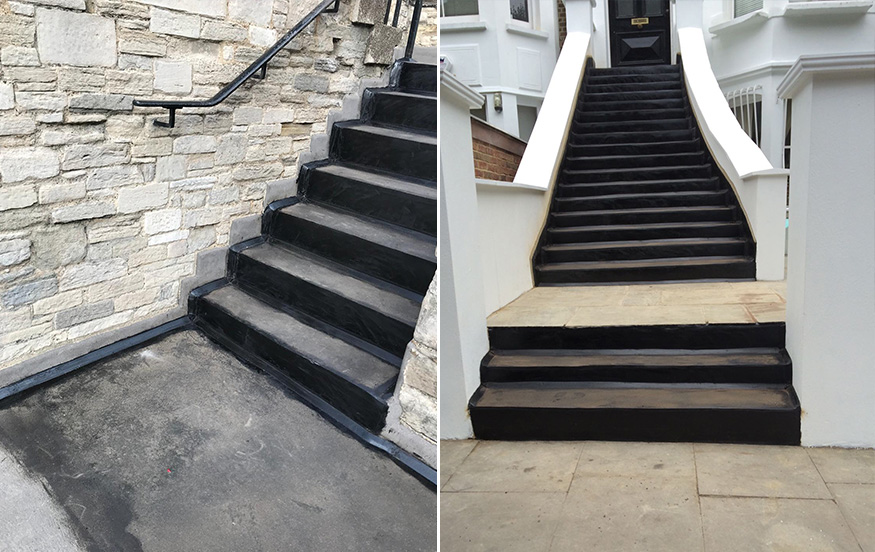More and more MAC members are seeing a surge to waterproof the basements of town houses up and down the country, which is carried out by a highly skilled application of mastic asphalt to treads, risers and landings. Malcolm Grinstead, Director at MAC, explains more about why mastic asphalt is the best product for the job.
Mastic asphalt is most commonly used for flat roofing applications but due to its waterproofing properties and durability, roofing grade mastic asphalt is increasingly being specified to protect exterior steps. Member contractors of the Mastic Asphalt Council (MAC) are reporting huge demand for the waterproofing of steps on townhouses in London.
Contractors such as R J Evans are carrying out at least five asphalt step refurbishment projects a month in the capital, in order to waterproof steps leading down to basement apartments or leading up to the front doors of Victorian townhouses which are amongst the most sought-after and highly priced properties in London today.
It is essential to keep steps and walkways completely waterproof in order to preserve the materials they are constructed from, to prevent structural defects, to prevent them from becoming a safety hazard and to enhance their overall appearance. Mastic asphalt is particularly popular on stone and concrete steps which are susceptible to cracking and deterioration over time, allowing water through into basement apartments and becoming dangerously slippery in the rain.
Waterproofing is carried out by the highly skilled mastic asphalt operatives, applying the product to provide effective long-term waterproof protection, a smooth finish, non-slip properties and durability to withstand constant foot traffic. Water ingress can prove to be extremely costly and disruptive and mastic asphalt has proved to be a highly effective solution for keeping basement apartments dry and free from water penetration.
Correctly applied, mastic asphalt steps will stand the test of time, lasting for up to 30 years. Treads are formed in roofing-grade asphalt and laid in two coats to a thickness of 25mm, the first coat being 10mm thick and the second coat being 15mm thick incorporating 10% to 15% of additional 3mm coarse aggregate, excluding a separating membrane.
Risers are formed in roofing-grade asphalt and applied in two coats to a thickness of 13mm, completed prior to laying treads. Strings are formed in roofing-grade asphalt and applied in two coats to a thickness of 13mm, dressed into a continual 25mm x 25mm chase, constructed either parallel to the pitch of the stairs or stepped vertically and horizontally to follow the line of the treads and risers. Strings over 300mm high are applied in three coats to a thickness of 20mm.
Shane Parker, Contracts Manager at R J Evans said: “The bulk of our work using roofing grade mastic asphalt is for roofing applications, but we have seen a surge in demand for asphalt application on steps and we carry out virtually all our work in London. Mastic asphalt is simply the best product for the job as you can manually form it, it’s very malleable and workable and there are no voids, meaning that there is no threat of water penetration.
“Repairing steps and walkways used to be a highly disruptive process which often meant the area would not be accessible for a lengthy period of time, causing disruption to homeowners and tenants, but mastic asphalt is very quick and easy to apply. The installation process is fast, providing a completely waterproof surface and, if additional layers need to be applied, it is very easy to do so. The finished product is maintenance-free and will last at least 30 years, meaning it is also highly cost-effective for property owners,” he continued.
Townhouse steps present themselves in a variety of different sizes and shapes, with railings, basement access, doorway steps and open areas.The flowing characteristics of mastic asphalt make it easy for installing contractors to refurbish surfaces which are complex, stepped or with protrusions. In many cases, mastic asphalt is also used in other areas, such as protection of purpose-built balconies which are constructed in London to offer increased living space.
Mastic asphalt can be trafficked within a few hours and it also has zero water content, which means there is no waiting for moisture to evaporate, and eliminating the risk of cement stained water entering the structure. It is well-known for being durable and long-lasting but specifiers and clients may be less familiar with its environmentally friendly credentials. Mastic asphaltis carbon neutral – a massive bonus for any building owner anxious to show their green credentials and, when it has reached the end of its useful life, the product can be recycled or used as roof screed, minimising the impact on the environment. Ten years ago the mastic asphalt sector became the first industry in the world to achieve the CarbonZero standard.
In terms of application, masticasphalt is one of the few construction activities still regarded as a ‘craft trade’. The skilled work involves ensuring that asphalt is laid at the correct temperature, and then spreading it using traditional techniques to coat the surface. A thermoplastic material that changes shape when heated, mastic asphalt cures to form a hard, durable, finished product to suit a wide variety of applications. To maintain the industry’s reputation and ensure a high quality finish on every single project, only trained applicators are permitted to install mastic asphalt under the Mastic Asphalt Council’s strict rules.
This article featured in the online June edition of RCi magazine – click here to take a look.

